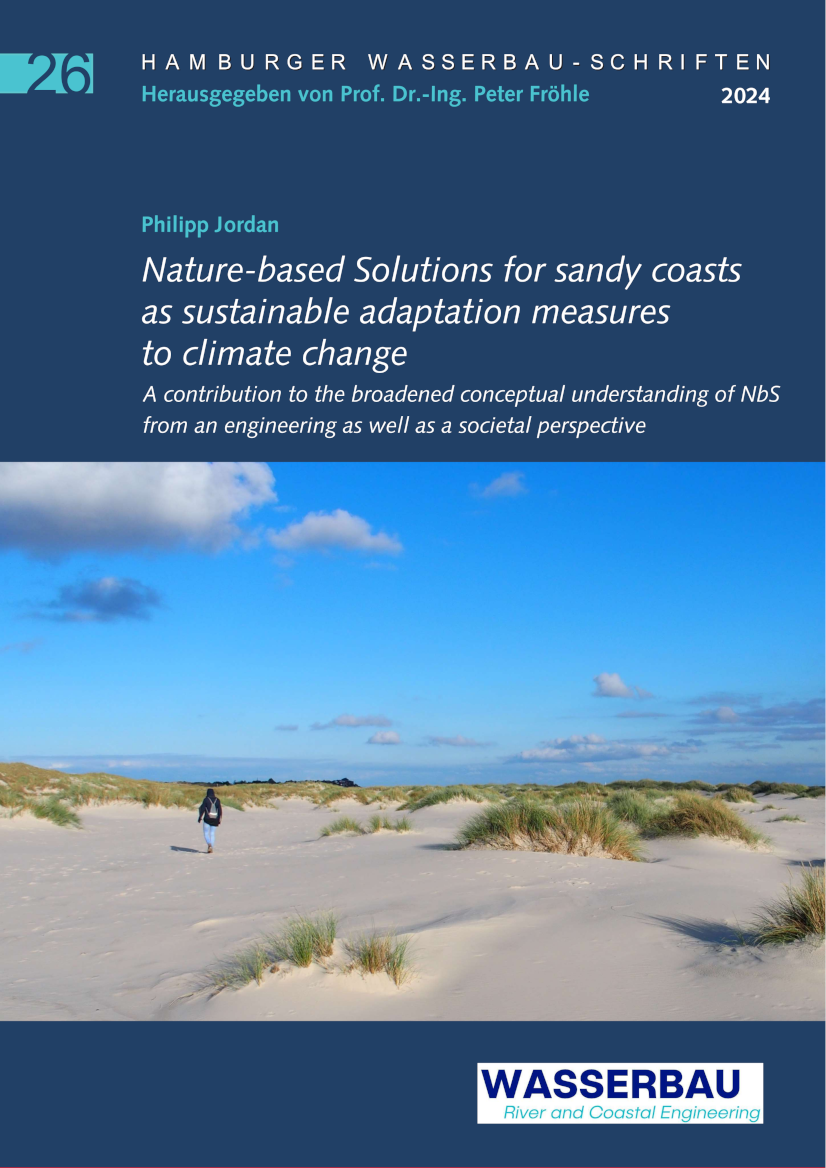Band 26: Nature-based Solutions for sandy coasts as sustainable adaptation measures to climate change - a contribution to the broadened conceptual understanding of NbS from an engineering as well as a societal perspective


Dissertation von Philipp Jordan
2024
Deutsch:
Jahrhunderte lang war der Küstenschutz geprägt vom Kampf gegen die Natur. Heute ermöglicht er ein sicheres Leben und Wirtschaften an der Küste. Der Klimawandel aber stellt neue Herausforderungen an den Bestand und erfordert erhebliche Anpassungen. In Kombination mit einem Paradigmenwechsel in der gesellschaftlichen Sicht auf die Küstenlandschaft und die Natur wird ein Diskurs über technisch möglichen, nachhaltigen und sinnvollen Küstenschutz der Zukunft angeregt. Naturbasierte Maßnahmen (NbS) stellen eine vielversprechende Anpassungsoption für sandige Küsten dar, weil sie neben dem reinen Schutz auch einen ökologischen und gesellschaftlichen Mehrwert bieten. Damit diese in der Küstenschutzpraxis etabliert werden und ihr Potenzial für Wasser, Natur und Mensch voll ausschöpfen können, ist ein erweitertes Verständnis von NbS sowohl aus ingenieurwissenschaftlicher als auch aus gesellschaftlicher Perspektive notwendig.
Die vorliegende Dissertation setzt mit einem inter- und transdisziplinärer Ansatz an diesem Punkt an, um die Fragestellungen aus unterschiedlichen Disziplinen und Akteursperspektiven zu betrachten und über das Spektrum der einzelnen Disziplinen hinaus zu bearbeiten. Beispielhaft für sandige Küsten werden die Inseln Amrum und Föhr als Untersuchungsgebiet ausgewählt. Mittel einer systematischen Literaturrecherche wird ein Einblick in die Entwicklung des Küstenschutzes und sein charakterisierendes Rational gewonnen. Wie dieses in den Köpfen der Menschen verankert ist, wird durch die Analyse durchgeführter, halbstrukturierter Interviews untersucht. Es zeigt sich eine dynamische Entwicklung, die durch das Experimentieren mit verschiedensten Küstenschutzmaßnahmen gekennzeichnet war. Während bewährte Maßnahmen wie der Deichbau oder die Dünenbepflanzung überwiegend als sinnvoll und vorläufig vertrauenswürdig bewertet werden, wird vermeintlich neuen Konzepten wie NbS zunächst oft mit Skepsis begegnet. Sie lassen sich nicht ohne Weiteres in das etablierte Kategoriensystem des Küstenschutzes einordnen. Die strukturierte Analyse und Hinterfragung der Grundannahmen hinsichtlich Küstenökosystemen als NbS zeigt, dass diese eine Chance bieten, bestehende Konflikte zu überwinden. Dank ihrer natürlichen Resilienz stellen NbS ergänzend zum bestehenden Küstenschutz eine nachhaltige Anpassungsoption an den Klimawandel dar. Um das Verständnis von NbS aus einer ingenieurwissenschaftlichen Perspektive zu erweitern, werden durch eine konzeptionelle Analyse die Eigenschaften der NbS, die die ingenieurtechnischen Stellschrauben darstellen, identifiziert und ihre Rolle sowie Wirkungsketten in Bezug auf Leistung, Beständigkeit und Resilienz herausgearbeitet. Um das Verständnis von NbS aus gesellschaftlicher Sicht zu erweitern, wird eine sozialwissenschaftliche Analyse der Kernanforderungen der Küstenbewohner an den Küstenschutz durchgeführt. So können Küstenbewohner NbS in ihr etabliertes Kategoriensystem Küstenschutz einordnen und mit ihren Wertvorstellungen verknüpfen. Küsteningenieuren verdeutlicht das Konzept außerdem die Bedeutung und das Potenzial gesellschaftlicher Aspekte für die effektive Kommunikation und Realisierung von Maßnahmen.
Beide Perspektiven tragen zu einem erweiterten konzeptionellen Verständnis von NbS bei, damit sie als nachhaltige Anpassungsmaßnahmen an den Klimawandel in der allgemeinen Praxis etabliert werden können, und so letztlich zur Re-Diversifizierung des Küstenschutzes für eine erhöhte Resilienz beitragen.
Englisch:
For centuries, coastal protection was characterised by the fight against nature. Nowadays it enables a safe life and economic activity along the coast, but climate change poses new challenges to the existing coastal protection and requires substantial adaptations. In combination with a paradigm shift in society’s view of the coastal landscape and nature in general, a discourse on future technically possible, sustainable and sensible coastal protection is stimulated. Nature-based Solutions (NbS) represent promising adaptations for sandy coasts, providing ecological and societal benefits in addition to protection. In order for these to find their way into future common practice and to fully exploit their potential for Water, Nature and People, a broadened understanding of NbS from both engineering and societal perspectives is needed to facilitate cooperation at all levels.
The present thesis starts off at this point. Adopting an inter- and transdisciplinary approach allows the issues to be considered and analysed from different scientific disciplines
as well as actors’ perspectives. By combining a broad spectrum of analytical tools, insights can be generated that go beyond the spectrum of the disciplines involved. Exemplary for sandy coasts, the North Frisian islands of Amrum and Föhr are selected as investigation area. An insight into the evolution of coastal protection and its characterising rationale is obtained through a systematic literature review. How this rationale is anchored in the minds of people is investigated with an analysis of the assessment of protective measures based on conducted semi-structured interviews. In combination, both analyses reveal a dynamic evolution characterised by experimenting and tinkering with various types of coastal protection. Well-established measures like diking or stalk plantings in dunes, are prevailingly assessed as useful, adequate and trustworthy for the time being. Supposedly new concepts like NbS are initially often met with scepticism as they cannot be readily placed in the existing category system of coastal protection. The conducted review of coastal ecosystems as NbS discloses that they offer a chance to close this gap. Thanks to their inherent resilience, in addition to the existing coastal protection, NbS represent a sustainable adaptation option to climate change. To broaden the understanding of NbS from an engineering perspective, a conceptual analysis of the underlying processes within coastal ecosystems reveals and analyses the properties of NbS which can be fine-tuned and their role and interrelationships with regard to service, resistance and resilience. To broaden the understanding of NbS from a societal perspective, a socio-scientific analysis identifies the coastal dwellers’ key requests towards coastal protection. The Key Societal Requests can help coastal dwellers to contextualise NbS in their established category system of coastal protection and highlight the importance and the potential of societal aspects to coastal engineers.
Both perspectives add to a broadened conceptual understanding of NbS, so that NbS can find way into common practice as sustainable adaptation measures to climate change and, thus, ultimately contribute to the re-diversification of coastal protection for an increased coastal resilience.

